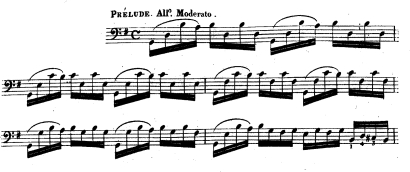
Ex. 1: Suite I Prelude, measure 27
by Sarah Freiberg
A few years ago, I wrote an article for STRINGS magazine, bemoaning the lack of a perfect edition of the Bach Cello Suites. Because there is no autograph, and since the Suites are so interpretation-friendly, there have been over 90 editions since the initial print of 1824. While some editors made use of the surviving 18th century manuscripts, others have imposed their own, more modern views on the works. Two of the manuscripts, copied by Bach's second wife Anna Magdalena and by organist Johann Peter Kellner, date from within a decade of their circa 1720 composition. There are two further manuscripts, both anonymous, which date from much later in the 18th century. The four manuscripts vary occasionally in pitch, but quite significantly in terms of articulation. This has left interpretation wide open!
Over the years, I have tried a variety of editions of the Suites, but often returned to my dog-eared and comfortably familiar copy of the old Anna Magdalena based Barenreiter edition. I found myself wanting something more comprehensive, something that would have compared all the manuscripts. I concluded my article by saying that I would prefer to choose my own articulations, based on my own comparison of the manuscripts. I imagined that other cellists felt the same way. I am happy to report that the new Barenreiter Urtext edition of the Suites allows cellists to do just that.
Edited by Bettina Schwemer and Douglas Woodfull-Harris, the new Barenreiter Urtext is billed as a "scholarly critical performing edition." It is exactly that. It contains all four manuscripts as well as the first (1824) printed edition. Each manuscript/edition is separately bound, and all contain measure numbers for easy comparison. Here you have the evolution of the first 100 years of the Bach Suites at your fingertips! (Barenreiter had previously provided a miniature score of all four manuscripts. Its advantage and disadvantage was its small size: easy to carry around but not so easy to read. Also, all four manuscripts were bound together, making measure by measure comparison cumbersome.) There is also a volume of commentary that compares the sources, provides useful information on 18th century performance techniques and puts the Suites in a historical context. The final volume is an unadulterated score for the performer.
The score contains neither bowings nor fingerings: these are for each cellist to provide. While there have been other editions without bowings, this one has the added advantage of clearly marking all the discrepancies among the five sources. For example (see Example 1 below), in the Prelude of Suite I, measure 27 concludes in the earlier manuscripts with the notes A,C,E,G A,C#,D,C#. The two later manuscripts, and the first printed score-which all harken back to a now lost source, read as a scale: A,C,E,F#,G,A,B, C#. In the new Barenreiter score, the later reading is shown in smaller notes between measures 27 and 28. Performers might want to cross out the reading that s/he isn't using, lest they end up playing both alternatives.






The printed source -- published in Paris in 1824 -- was produced a full century after Bach's composition of the Suites. It reflects the changing role of the works: no longer are they listed as "Suites" on the front page -- here they are referred to as "Sonates ou Etudes." Perhaps the four note slurs at the start of the First Prelude (marked here as Allegro Moderato!) reflect this focus on etudes or studies: one must be able to do the string crossings of the separate notes on beats two and four of each measure starting either up or down bow. That certainly makes a good study. This source is also illuminating in terms of early 19th century cello playing, since it includes some fingerings. While it doesn�t totally avoid open strings, it makes far less use of them than was 18th century custom. In the Prelude of the Fourth Suite, the fingerings suggest that one stay in one position as long as possible -- I know I am accustomed to jumping around much more. (Not that I�ve ever found perfect fingering for this movement.) The Sixth Suite, which was intended for a five-stringed instrument, becomes quite a workout when played on a four stringed cello. The first edition makes ample use of thumb position here, which was not used in Bach�s time. This edition also has a number of added dynamics; Bach was sparse with them!
Rather than continue to give examples of the differences between the sources, I urge my fellow cellists to check out this new Barenreiter edition of the Bach Suites themselves. It really shows us all the options and lets us make our own choices. While making one�s own edition is time-consuming and challenging, this Urtext provides a lot of guidance. Even if you prefer other editions, this is an invaluable resource for any cellist.

| Direct correspondence to the appropriate ICS
Staff Webmaster: Michael Pimomo Director: John Michel Copyright © 1995- Internet Cello Society |
|---|